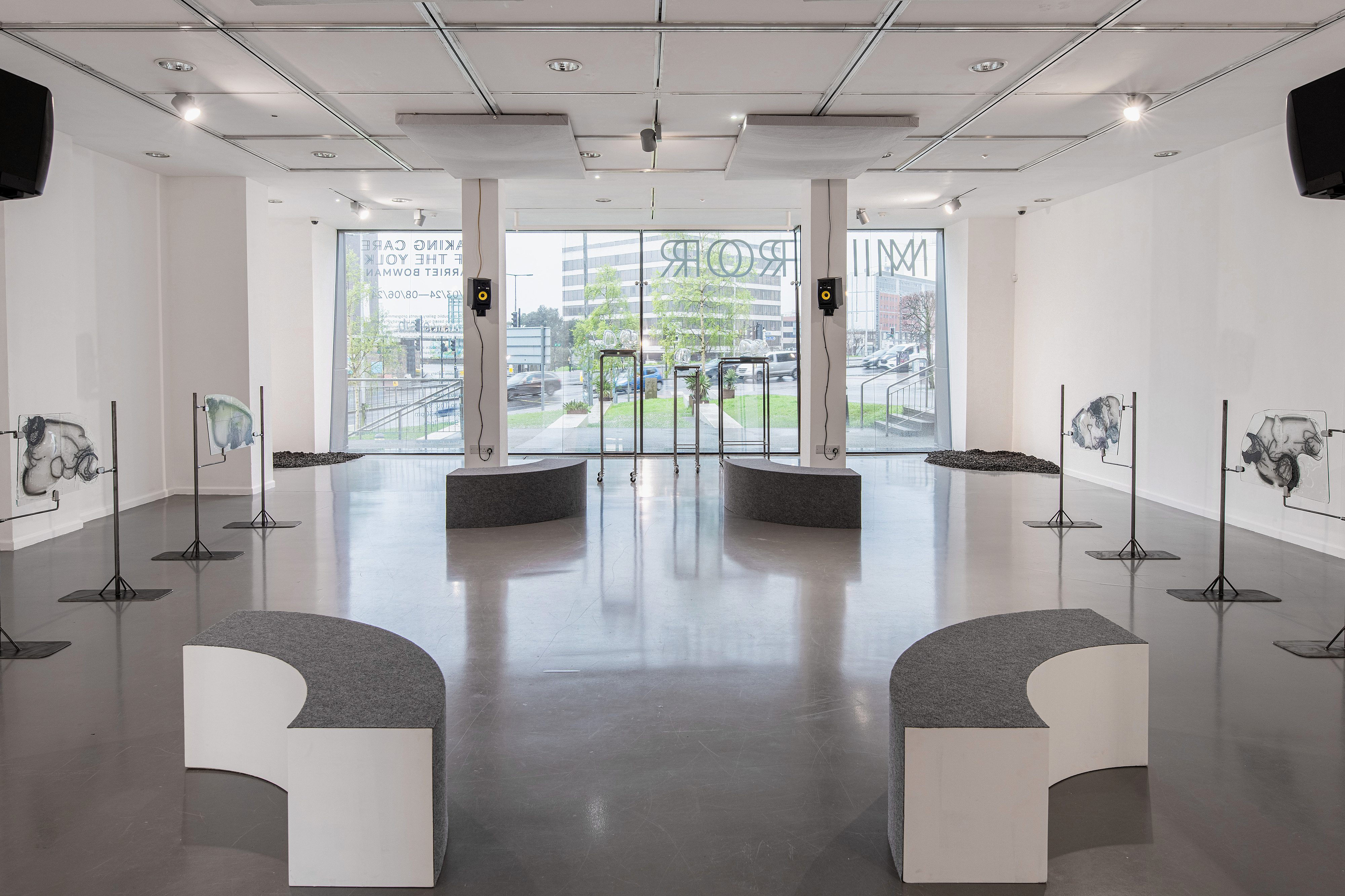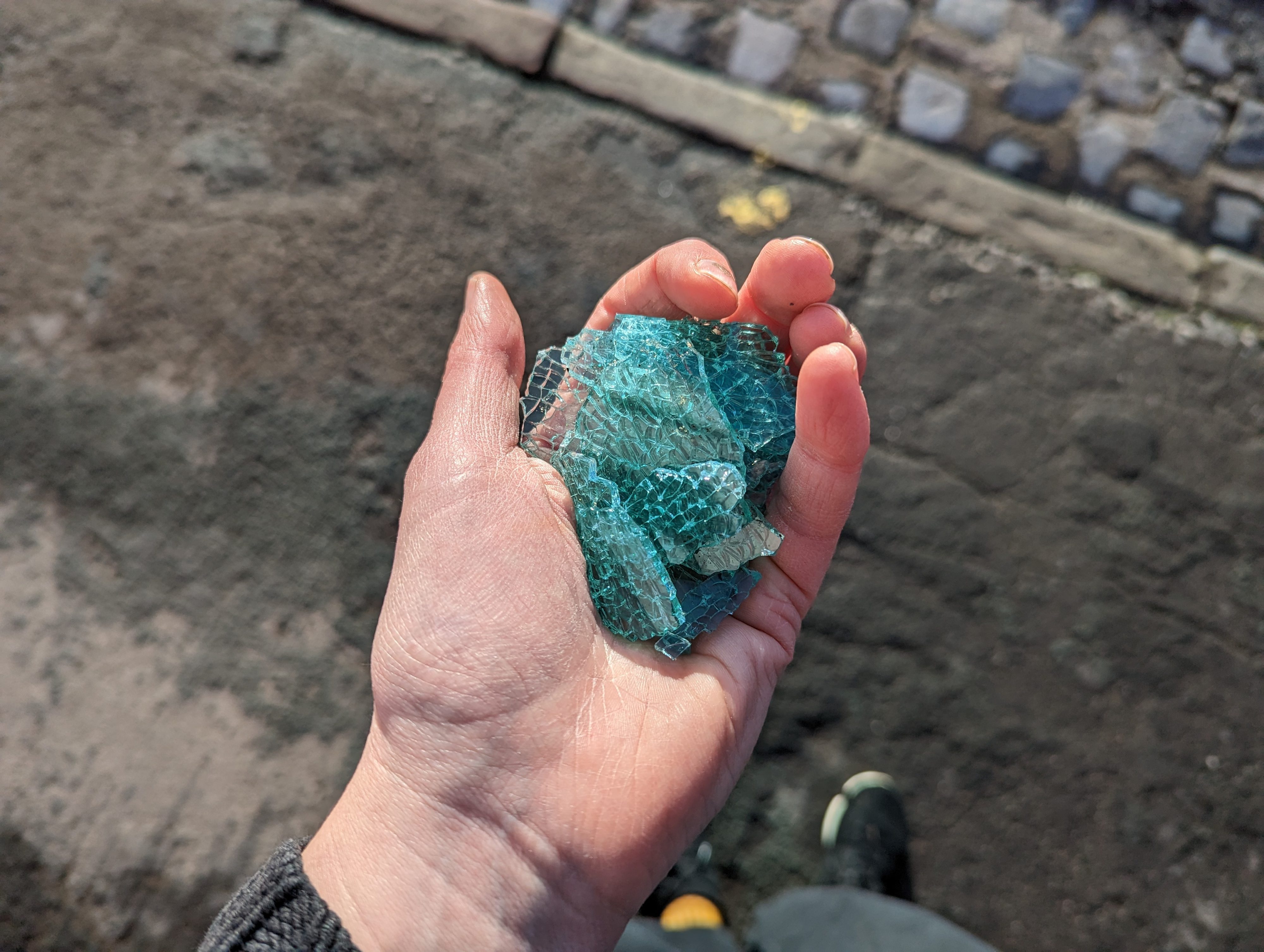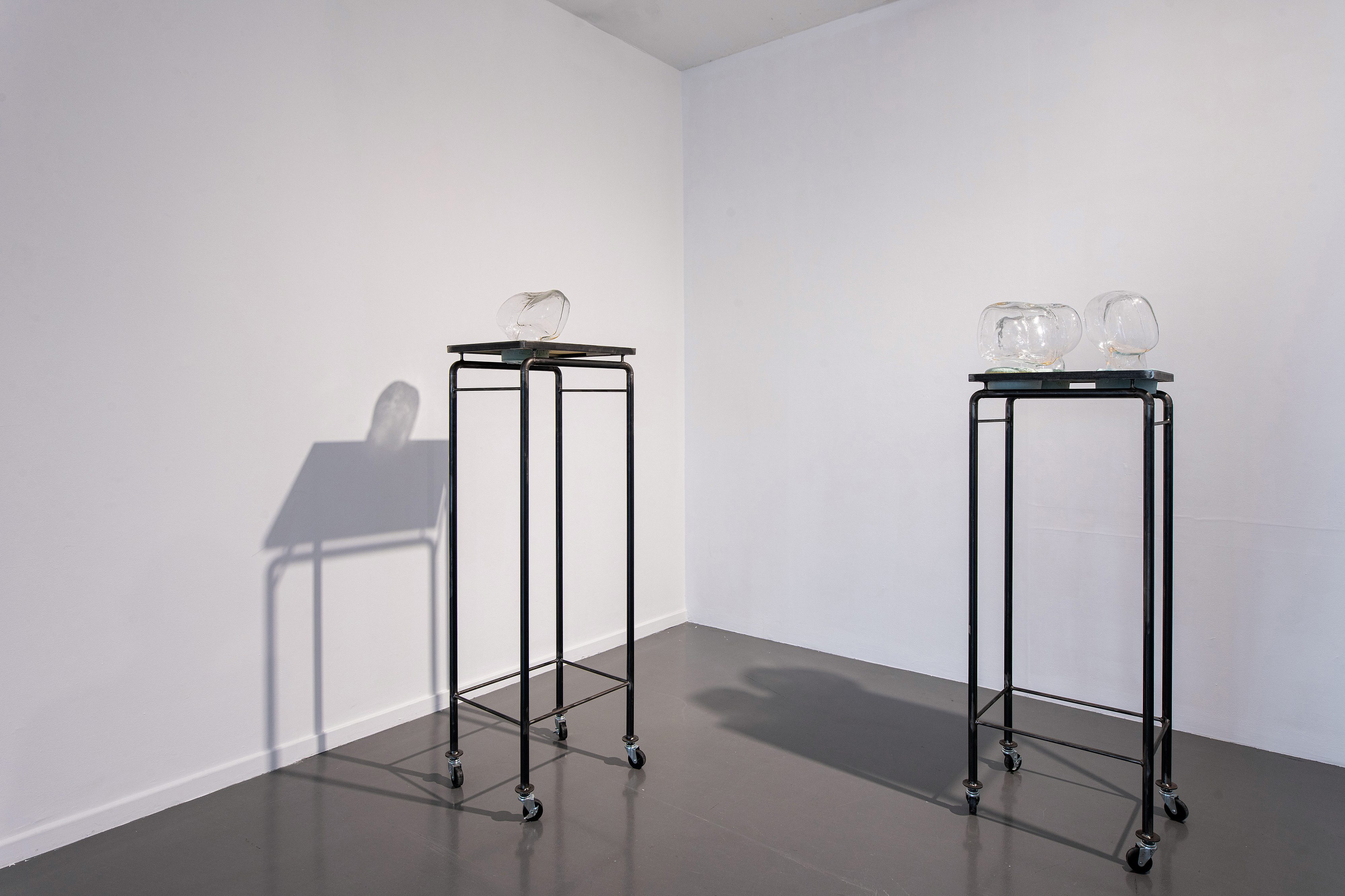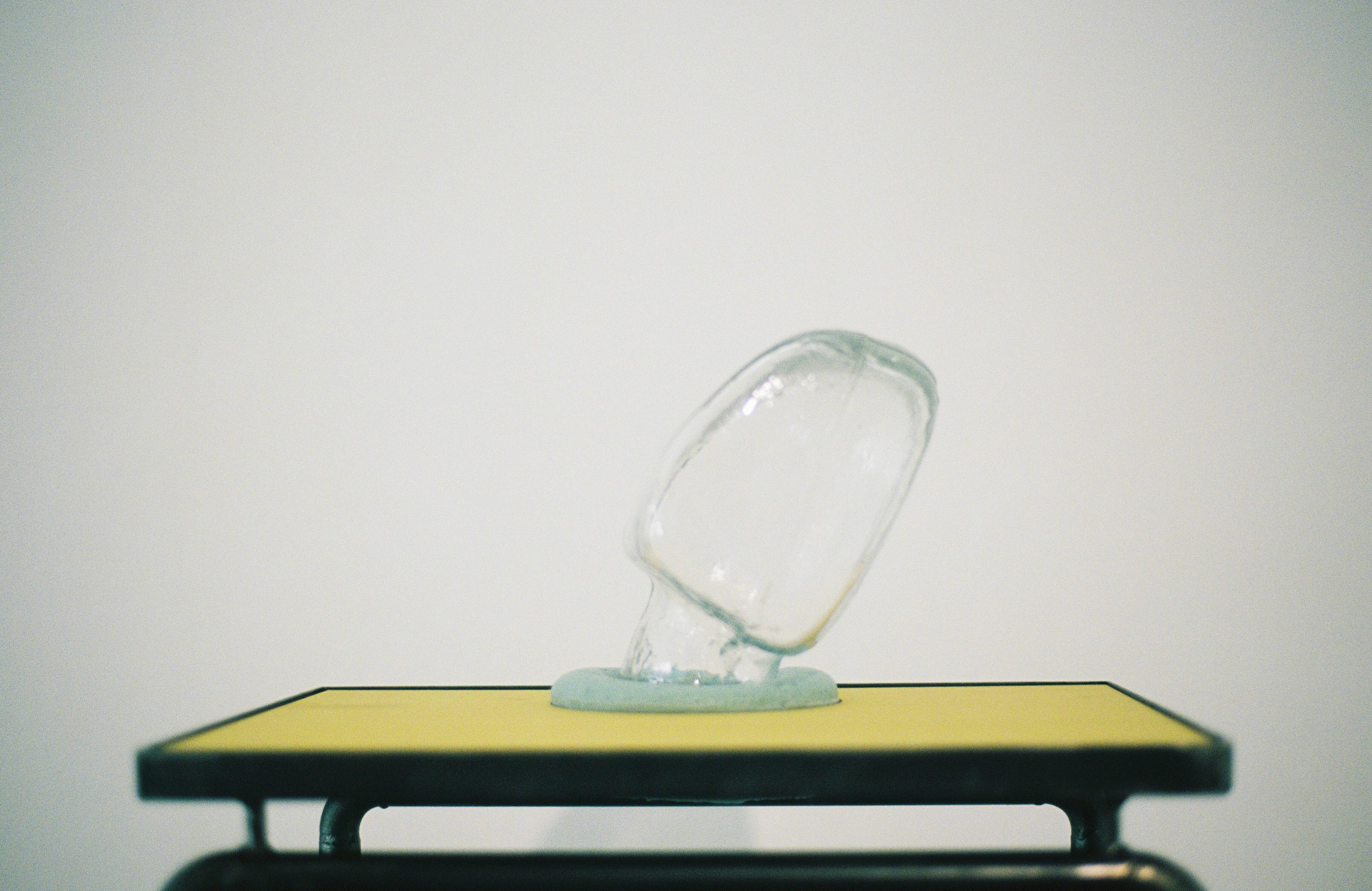Artist Spotlight: Harriet Bowman
We catch up with Axis Fellowship cohort member, Harriet Bowman, to chat about their work.
(detail) Drivers Side (front), 2024. Fused float glass, horse hair (ash), welded metal frames, balustrade clamps. Photo by Dan Weil
Tell us a bit about yourself and your practice, how would you describe the work that you do?
This is always a tough question to answer as it feels like my answer is always changing and the outcomes and materials are often in flux, moving and shifting depending on what I’m researching or writing.
I spend weeks writing, focusing on a narrative, or reflecting on an experience, or learning in detail about a material process, other times I’m gleaning car window glass from the pavement behind my studio or talking to windscreen repair people seeing where I can find an Audi windscreen from the 2009 A2 model.
I weave all of these processes together to make sculpture, often through intensive processes of learning, testing and experimentation, by being on site in industrial spaces or in my studio at Spike Island testing and experimenting with materials.
I examine the vulnerability of the body in relation to materials and the bodies of others used within the processes of production. The sculpture I make takes the form of: installation, objects, performance, photographs, narrative texts and audio. Writing exists alongside sculpture adding texture in printed matter, spoken word performance, textures and layers in installations.

One of the things you wanted to explore more deeply during the fellowship involved material description as sculpture. I wondered whether you could tell us some more about this, and where the decision to explore sculpture in this way has come from?
When I was applying for the Axis fellowship I had just found out I had been awarded the South West Showcase. My proposal for the SWSC focused on using an excerpt of writing I had been developing over the past year or so and using it as a material on the surface of a show. The texts would often go on to inform how I went on to make sculpture, however for this show I planned to use the writing as a raw material to produce an audio work.
Writing is the vessel or vehicle I use usually as the starting point, it is a key part of my process. Sometimes it exists buried below the surface, at other times it is performed as part of the sculpture.
Over the last few years I have been writing hybrid scripts working with words that surround material in an attempt to build a denser material and at time dematerialise sculpture, or re-materialise it within a web of language. I am building layers by gathering evidence and investigating material. Trying to see if I write a narrative, learn the process in detail, work with the physical material, interview the humans involved, explain how it smells, meet the non-humans, stroke the machines and look at marks left in the traces of oil - can I build a denser body of work? I have at times tried to dissolve the physical material from my practice, this is something I still grapple with and don’t think I will ever resolve. I have come to learn that at times the language material will stand in for the ‘physical’ but often the two will come together and collide in an attempt to ‘swell’ the material and it is this ‘swelling’ of material that I am very interested in.

For your recent exhibition, Taking Care of the Yolk, at Mirror in Plymouth, this type of material description was expressed through a sound work. How did using sound, rather than written word, change your descriptive investigations?
As I mentioned earlier part of my proposal for the SWSC commission I wanted to explore my writing practice by bringing it into the gallery space for the first time. I started by extracting parts of these texts and expanding them, layering them with detail, I was trying build sculpture through writing material.
With the SWSC budget I bought myself a small Tascam and carried it around with me everywhere. It became an extension of my body. I would record and read from scripts most days, sometimes driving out to remote lay-bys to get a recording of a long honking horn (hard to do in the city without causing unnecessary stress!), I’d record under cover in cafes to get the ‘perfect’ background sound.
The sound was a way I could think about space in ways I hadn’t before, it became sculptural, by layering and building the audio I could imagine it taking up physical space in the gallery.

You’ve mentioned previously that working with sound has opened you up to much more collaborative ways of working, can you tell us more about these processes?
Before the show at MIRROR I hadn’t worked with sound; it was a material I had been interested in exploring for years but felt out of reach. As part of the award I had access to the facilities at The Arts University Plymouth and was introduced to Neil Rose who is a senior lecturer on the Film and Screen Arts course.
Neil and I worked together on what became the audio for ‘Taking Care of the Yolk’. I shared extracts with text with Neil and a rough sense of the narrative and Neil ran with it. I would send him recordings I’d been gathering each day. Sometimes field recordings, other times multiple takes of scripted text I’d been working on. Neil would send instructions back like "can you breathe a bit deeper" or "faster", or "record this part from below your chin", and "MAKE SURE YOU ARE IN A CAR."
I would take the Tascam into the hot glass fabrication department at The Arts University and record the process of blowing the glass headrests and the billowing sounds of the furnace. Through Neil’s sound design parts of these recordings were extracted and used to build the expansive soundscapes that exist throughout audio work.

Speaking of collaboration, could you describe to any artists who are considering applying for this year’s Fellowship Programme, how the fellowship has helped you to realise this body of work?
Having the fellowship alongside preparing for a show was such a useful process. Over the course of the months each artist had a dedicated session to share work or works in progress with the group for feedback and open up conversation and thinking about potential developments or references for the work. It was a safe and generous space for sharing new work.
For my session I was able to share an early version of the audio piece. The fellowship group gave vital feedback and highlighted parts which they felt were successful and bits that could be expanded or that I could spend more time on.
I am so grateful for the groups time they took to feedback on my work as well as being lucky enough to get glimpses into their exciting practices and future plan. Thanks Farida, Sam and Charlotte, and of course Harlan for hosting as well as being a vital part of the group.

You’ve had a very busy year with various different residencies and opportunities, what have you got coming up for the rest of the year?
You're right! It has been a very busy year with my show ‘maybe they had an urgent call’ at Exeter Phoenix in May 2023, then working towards the South West Showcase at MIRROR Plymouth, which opened in March, and recently winning the Mark Tanner Sculpture Award. Over the last year I have been accessing the facilities at The Arts University Plymouth as a ‘Creative Associate’. I have been fortunate enough to have this position extended as I work towards the MTSA touring show opening at Standpoint Gallery, London in May 2025. I am just beginning to build plans and look at materials as I start my research towards the show in May.
Artists
Tags, Topics, Artforms, Themes and Contexts, Formats
Share this article
Helping Artists Keep Going
Axis is an artist-led charity supporting contemporary visual artists with resources, connection, and visibility.



